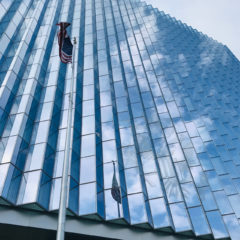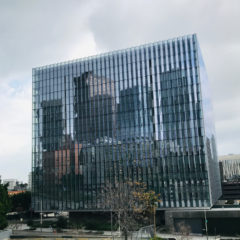The Faux Populism of Trumpified Architecture
Bloomberg Opinion , February 11, 2020
Even on a gloomy Sunday, with skies threatening rain, the U.S. Courthouse on First Street in downtown Los Angeles is strikingly beautiful. The clouds and surrounding buildings reflect in its pleated glass sides, which look far airier in person than in photographs. By breaking up its plane, the pleats call attention to the Great Seal etched in the glass. The American flag reflects in their panes.
Opened in 2016, it’s a civic building that makes you happy to see it. Reviewers on Google and Yelp, including a grumpy juror, give it good marks.


Catesby Leigh, by contrast, calls it a “Borg Cube.” I can only assume he has never actually watched “Star Trek: The Next Generation.” Or maybe he’s too blinded by architectural theory to enjoy beauty that doesn’t conform.
You probably haven't heard of Leigh. He’s a critic associated with the National Civic Art Society, a think tank that “endeavors to help architecture return to its pre-Modernist roots.” The society wants government buildings to re-adopt classical architectural styles: more domes and columns, less glass and steel. Its formerly obscure views are now enjoying the world’s largest megaphone.
Last week, a draft executive order titled “Making Federal Buildings Beautiful Again” leaked to Architectural Record. (The Chicago Sun-Times obtained a copy and put it online.) The draft denounces modern architecture. It requires classical styles as the default architecture for all new federal buildings in the Washington D.C. area, including surrounding counties; for all federal buildings costing more than $50 million; and for all federal courthouses. It specifically forbids Brutalist and Deconstructionist styles. It establishes a President’s Committee for the Re-Beautification of Federal Architecture to revise the principles that guide federal architecture commissions.
It calls for the General Services Administration to solicit public comment on new building designs while specifically excluding “artists, architects, engineers, art or architecture critics, members of the building industry or any other members of the public that are affiliated with any interest group or organization involved with the design, construction or otherwise directly affected by the construction or remodeling of the building.”
You could see that requirement as avoiding conflicts of interest — or as excluding anyone who knows what they’re talking about.
Architects and critics were apoplectic.
Classical styles are fascistic, suggested Artnet News. The Guardian warned of “dictator chic.” The order would constitute “a complete constraint on freedom of expression,” an architect told the New York Times. Even a nuanced historical article in Archinect News concluded with a reference to Nazi architect Albert Speer. New York Times critic Michael Kimmelman rightly identified the draft as Twitter bait.
The response demonstrates how, even when he’s barely involved, President Donald Trump manages to effectively troll snooty elites by giving voice to widely held popular grievances. A lot of government buildings are indeed ugly. No matter how hated, they rarely get torn down. But the draft order also demonstrates Trump’s propensity for ham-handed remedies that would do more harm than good.
As creators, architects face an inherent problem. They can’t do their work without clients. Writers, painters, sculptors — these days even filmmakers — can find ways to follow their muse even if their creations have little or no market. Beyond building homes for themselves (or their mothers), architects have few options.
Construction is expensive, it requires land, and it needs people who’ll use it. That’s the real-world conflict at the heart of Ayn Rand’s novel “The Fountainhead,” which lampooned the throwback styles and populist attitudes the draft order promotes.
Federal commissions offer relative freedom for architectural ambitions. “Design must flow from the architectural profession to the Government and not vice versa,” declare the guidelines in place since 1962. Written by a young Daniel Patrick Moynihan, these design principles reflect the technocratic modernism of the Kennedy era — the deference to experts and belief in the new that landed a man on the moon but also razed urban neighborhoods to make way for Brutalist government centers.
Under those guidelines, the architecture profession itself acts as the client. The result can be a masterpiece like L.A.’s new courthouse — or a monstrosity like the headquarters of the F.B.I., the J. Edgar Hoover Building, one of Trump’s pet peeves.
By contrast, the advocates of classical architecture position themselves as the voice of the people. “For too long architectural elites and bureaucrats have derided the idea of beauty, blatantly ignored public opinions on style, and have quietly spent taxpayer money constructing ugly, expensive and inefficient buildings,” the National Civic Art Society’s chairman told the Times.
But if architects can’t represent the public, who can? That’s the problem at the heart of any government building project. Whose taste should rule? What should the balance be between saving money and creating meaningful, attractive buildings? What role should the people who’ll work in the building have? What is the right form for the building’s specific use? For federal buildings outside the capital, what voice should locals have? Who speaks for the client when the client is everyone?
These are political, not technical, questions. You can’t reason your way to the single right answer. You can only try to strike a sensible balance — which isn’t exactly the Trump way.
In an editorial attacking the executive order, the Chicago Sun-Times evoked the city’s federal plaza designed by Ludwig Mies van der Rohe. Ordinary locals find it striking, part of Chicago’s heritage of beautiful architecture, including many modern buildings.
Leigh, by contrast, says the plaza “raises serious issues of appropriateness” and is “far better suited to the high-end corporate world and its promotion of itself as culturally au courant.” (The building was au courant a half century ago.) Dictating that your idea of civic appropriateness is right for all buildings in all times and places shouldn’t be confused with speaking for the public.
What looks “civic” depends on experience, not architectural theory. In Los Angeles, where I live, traditional civic buildings are not classical. They’re not even the Mission style popular elsewhere in the state. They’re Moderne ziggurats with Art Deco features, like the L.A. city hall, or midcentury modern structures like the Wilshire Federal Building in West L.A. They reflect the eras in which the city was rapidly expanding.
Some, like these examples, are attractive and popular, others less so. But all of them represent the actual city and its history, not an outsider’s idea of civic ideals. The eco-conscious 21st-century beauty of the new federal courthouse fits appropriately in its dense urban setting. Columns and domes would not. Neither would the red tile roofs of Santa Barbara.
However great it may be for the Lincoln Memorial, classicism itself is no guarantee of good civic architecture. Packing columns onto a hulking monstrosity like the Eisenhower (formerly Old) Executive Office Building does not make it beautiful. Historical, yes. Meaningful because of that history, sure. But not attractive or inspiring or representative of American ideals.
The sweeping language of the draft order simply replaces one group of architectural theories with another, one set of insiders with an even smaller one. Preserving the high-handed attitudes it claims to oppose, it avoids the hard questions. Even on its own grounds, its judgments and prescriptions are suspect.
This architectural tiff is an argument among intellectuals with ideas about the ought of the built environment, not citizens with experience of the is. It might make government buildings more uniform, but it wouldn’t make them better.